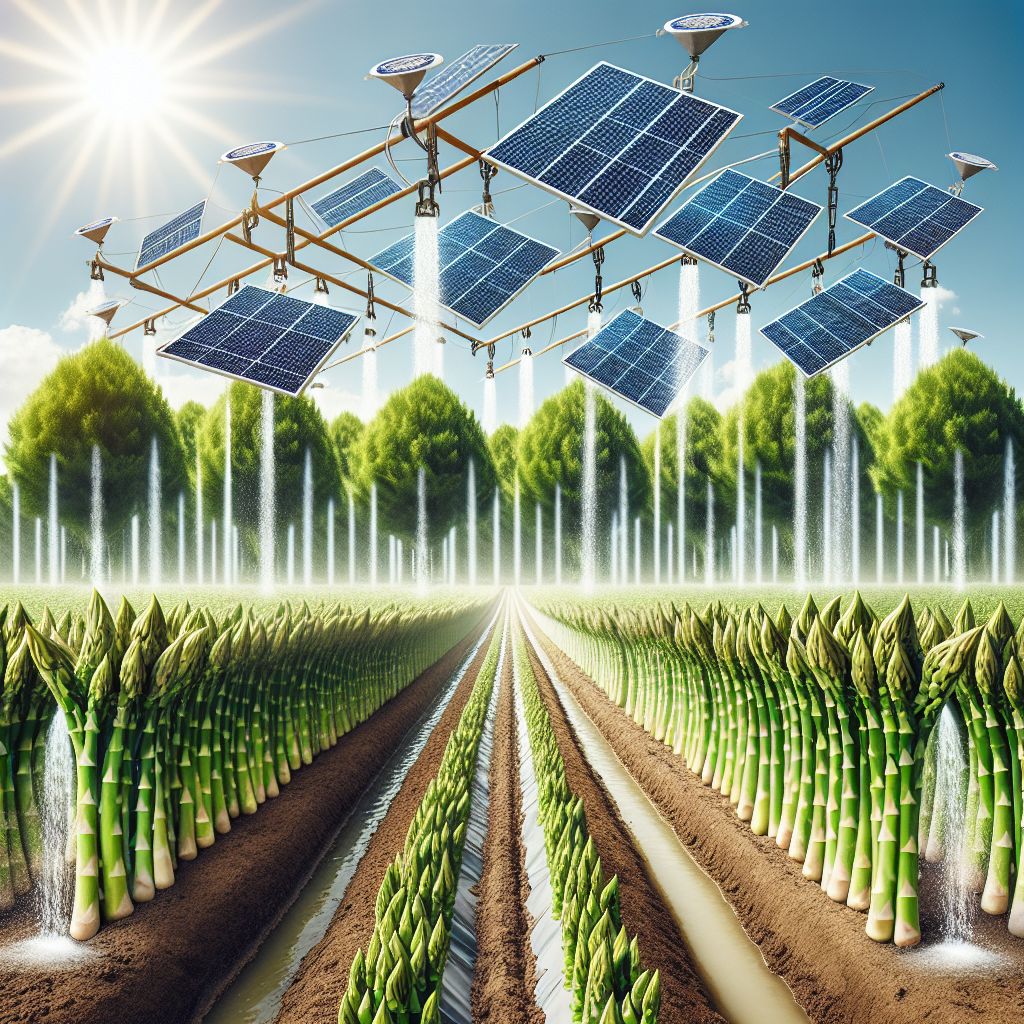
Key Takeaways:
Using solar power decreases dependence on non-renewable energy and lessens the production of greenhouse gases.
Pairing solar panels with irrigation systems can make the system more efficient and decrease the cost of operation.
Drip irrigation systems are very efficient for growing asparagus because they decrease water waste and focus nutrients.
Monocrystalline solar panels are the best choice for agricultural use because of their efficiency and longevity.
Switching to solar-powered irrigation could be a wise choice for asparagus farmers when considering the long-term benefits and sustainability.
Picture yourself walking through a field of asparagus with the green spears standing tall and ready to be harvested. Now, picture this lush growth being supported by the power of the sun, not only for growth, but also for the vital task of watering the plants. That is the potential of solar-powered irrigation systems—a combination of technology and nature that could change the way we grow food.
The Advantages of Solar Power and Irrigation Systems
First and foremost, solar power is revolutionizing the agricultural industry. It’s an environmentally-friendly, renewable energy source that is becoming more cost-effective every day. By using the sun’s energy, we can power irrigation systems without the need for fossil fuels, reducing pollution and greenhouse gas emissions. This is not only beneficial for the environment, but also for your bank account, as sunlight is free after the initial installation of the panels.
Benefits of Solar Power in Farming
If you’re an asparagus farmer, why should you think about using solar power? Solar panels, to begin with, can produce the electricity required to operate your irrigation pumps and systems. This means you’re less reliant on the grid and have more control over your energy expenses, which can fluctuate greatly for electricity. Additionally, if you reside in a region with a lot of sunlight, you’re sitting on a potential goldmine of solar energy that could be used to power your farm.
The Role of Solar Panels in Improving Irrigation Efficiency
This is where the magic happens. Solar panels have the ability to power electric irrigation systems directly or charge batteries to ensure a continuous power supply, even when there is no sunlight. This level of energy self-sufficiency allows you to water your asparagus at the most water-efficient time of day, which is usually early in the morning or late in the evening when evaporation rates are at their lowest.
Green Impact and Longevity
When you opt for solar-powered irrigation, you’re not just saving on your bills, you’re also preserving the earth you cultivate. Conventional energy sources can be tough on the environment, leading to soil and water contamination. Solar power is clean, which means you’re contributing to the preservation of the ecosystem for future generations of farmers and asparagus enthusiasts alike.

Types of Irrigation Systems for Asparagus Farming
Now, let’s talk about the irrigation systems. Asparagus, a deep-rooted plant, needs a steady supply of water, but too much water can cause root rot and other problems. That’s why the irrigation system you select is so important.
Understanding Drip, Sprinkler, and Furrow Systems
Asparagus farming primarily uses drip, sprinkler, and furrow systems for irrigation. Each system has its own unique benefits, and the choice of system largely depends on the specific circumstances of your farm, including factors such as soil type, weather, and water supply.
Drip Irrigation: Conserving Water with Accurate Water Delivery for Asparagus
Drip irrigation is akin to providing your asparagus with its own water flask. It supplies water straight to the plant’s roots, one drop at a time, decreasing evaporation and runoff. It’s exceedingly water-efficient, which is crucial in regions where water is either scarce or costly.
Sprinkler Systems: Mimicking Rainfall to Efficiently Water Asparagus Fields
Sprinkler systems are essentially a way to make it rain whenever you want. They can cover large areas and are fairly easy to install and move. However, they’re not as efficient with water as drip systems because some of the water evaporates before it hits the ground.
Traditional Furrow and Flood Irrigation Techniques
Furrow and flood irrigation have been used for centuries and are the traditional methods of irrigation. These techniques involve flooding the fields or running water down small channels (furrows) between the rows of asparagus. Although they are not as precise or efficient as drip or sprinkler systems, they can be appropriate for certain soil types and topographies.
Choosing the Right Irrigation System for Asparagus
Drip irrigation is the top choice for water conservation and targeted nutrient delivery.
Sprinkler systems work well for larger farms where water loss is not a major concern.
Furrow irrigation can work if managed properly, but it’s generally less efficient.
Here is a table showing the pros and cons of different irrigation systems a farmer can use on a farm:
|
Irrigation System |
Pros |
Cons |
|---|---|---|
|
Drip Irrigation |
– High water efficiency (90%+). 1 |
– High initial cost. 4 |
|
Sprinkler Irrigation |
– Relatively inexpensive to install. 5 |
– Lower efficiency than drip (60-80%). 1 |
|
Furrow/Surface Irrigation |
– Very low efficiency (50-60%). 1 |
Ultimately, the irrigation system that will work best for your asparagus will depend on your specific situation. However, if you’re seeking efficiency and sustainability, it’s tough to beat a combination of drip irrigation and solar power. It’s a match made in environmentally-friendly heaven. Now let’s take a look at solar panels.
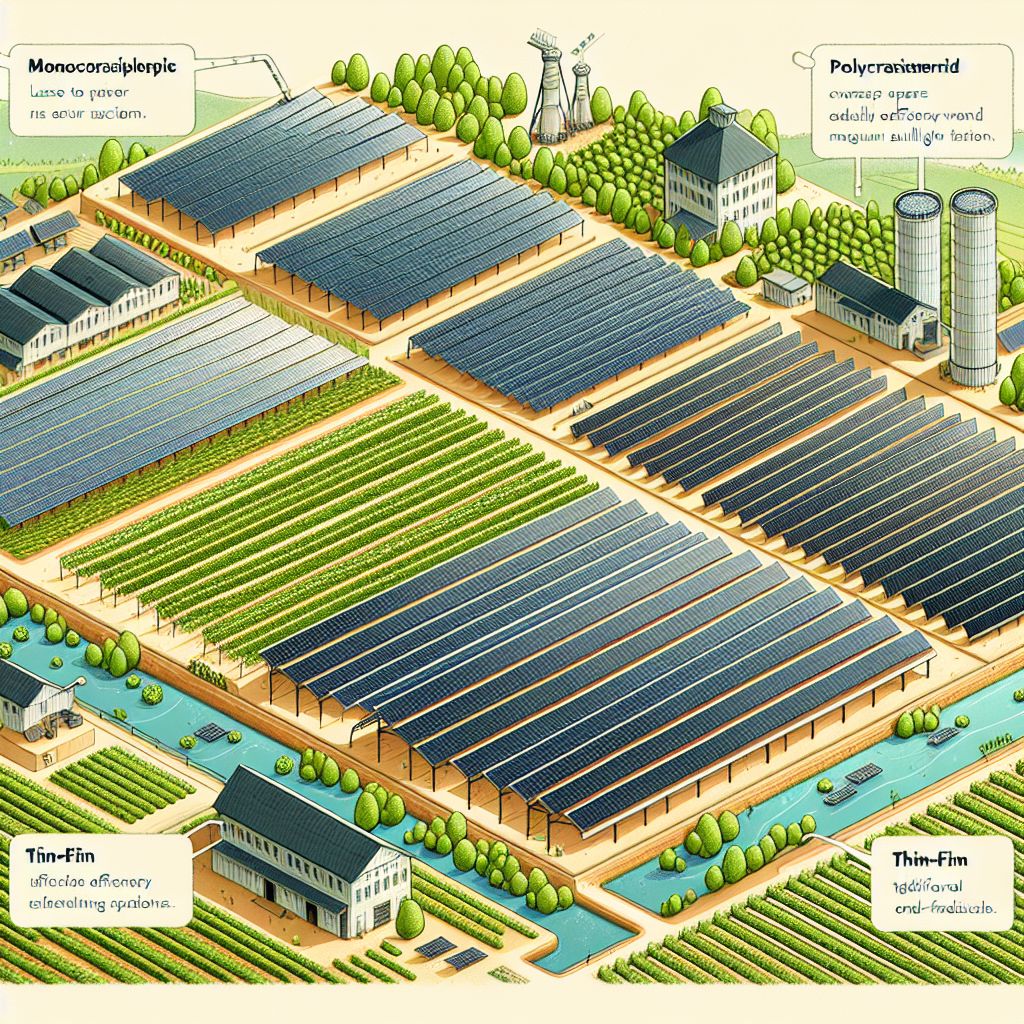
Top Solar Panels That Can be Incorporated into the Irrigation System for Asparagus Cultivation on a Farm
It is crucial to select the appropriate solar panels for the effectiveness and sustainability of the irrigation system on your asparagus farm. The three primary types of solar panels that can be used in agriculture are monocrystalline, polycrystalline, and thin-film, each with its own set of advantages and factors to consider.
Solar Panel Varieties: Monocrystalline, Polycrystalline, and Thin-Film
Monocrystalline panels are recognized for their superior efficiency and extended lifespan, making them a favorite among farmers with limited space but a high demand for power. Polycrystalline panels provide a middle ground between efficiency and cost-effectiveness. They are not as efficient as monocrystalline panels, but they are generally more affordable. Thin-film panels are the least efficient of the three, but they are light and flexible, making them suitable for a range of surfaces, including those that are not flat or have weight restrictions.
Monocrystalline Panels: Where Efficiency and Durability Meet
Monocrystalline solar panels are considered the best of the best. These panels are created from a single crystal structure, which makes them more efficient at generating power in a smaller space compared to other types of solar panels. They’re especially effective in areas with strong sunlight, and their sleek black design is often more attractive to homeowners.
Yes, it’s true that you’ll pay more upfront for a more efficient system. However, don’t let the initial cost scare you off. Monocrystalline panels are more durable and perform better over time, which can lead to significant savings in the long run. This makes them a smart investment in the future of your farm.
To illustrate, a farm that needs a 10kW solar panel system may only require 27 monocrystalline panels instead of 34 polycrystalline panels to reach the same power output. This advantage in saving space can be vital for a farm with a limited rooftop or land area.
Polycrystalline Panels: Economical and Dependable
Polycrystalline solar panels are a fantastic middle-of-the-road option. They are created by melting several silicon crystals together, which is less wasteful than the manufacturing process for monocrystalline panels. This makes them more economical, both in terms of production and purchase price.
Thin-Film Solar Panels: The New Kid on the Block
Thin-film solar panels are the new kids on the block in the world of solar energy. Their lightweight and flexible design means they can be installed in places where traditional panels can’t. So, think about all those odd spaces on your farm that could be turned into power generators – that’s where thin-film panels come into their own.
Nonetheless, there are a few downsides to consider. They are not as effective as mono and polycrystalline panels, implying that you’ll need a larger number of them to produce the same quantity of electricity. They also deteriorate more quickly, which might make them a less appealing option for a long-term investment.
Choosing the Right Solar Panels for Growing Asparagus
Monocrystalline panels: These are great for efficiency and saving space.
Polycrystalline panels: These offer a good balance between cost and performance.
Thin-film panels: These are perfect for non-traditional installation areas.
So, which solar panel should you choose? The answer will depend on the specific needs of your farm. You’ll need to think about the space you have available, your budget, and how much power you need to run your solar-powered irrigation system effectively. Remember, the aim is to build a sustainable and efficient system that will serve your asparagus farm for many years.
Here is a table showing the pros and cons of using different types of solar panels with an irrigation system on a farm:
|
Panel Type |
Pros |
Cons |
|---|---|---|
|
Monocrystalline Panels |
– High efficiency (15-22%), producing more power per square foot. 1, 2, 4 | |
|
Polycrystalline Panels |
– Lower upfront cost than monocrystalline. 1, 2 |
– Lower efficiency and shorter lifespan than monocrystalline. 2, 4 |
|
Thin-Film Solar Panels |
– Lowest upfront cost. 1, 2 |
– Lowest efficiency (7-13%). 2, 4 |
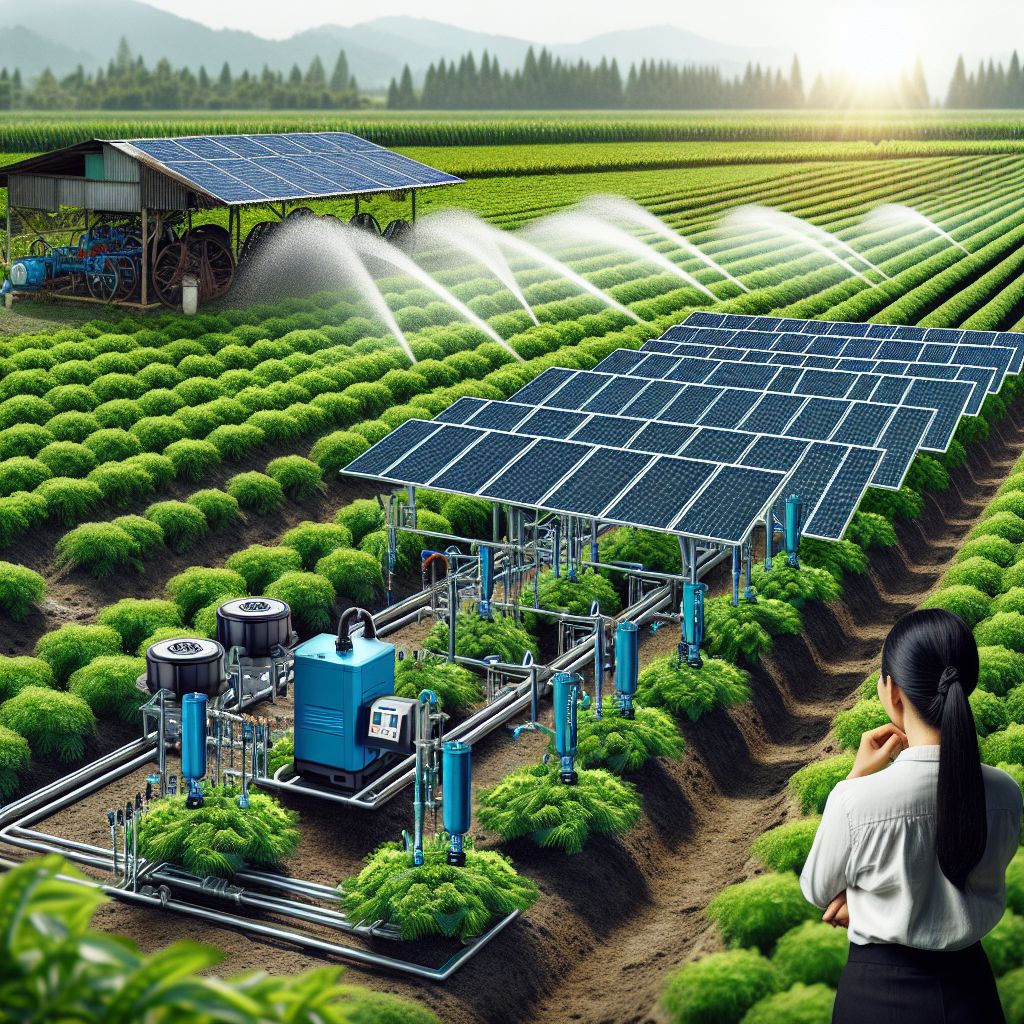
Cost Savings and Improved Efficiency in Asparagus Cultivation: A Comparison of Solar-Powered and Traditional Irrigation Systems
Efficiency is of utmost importance in asparagus irrigation. As a perennial crop, asparagus needs regular and dependable watering, which can consume a lot of energy. Traditional irrigation systems depend on grid electricity or diesel generators, which can be expensive and not very eco-friendly.
Understanding the Upfront Costs
There’s no denying that a solar-powered irrigation system requires a hefty upfront investment. You’ll have to buy solar panels, inverters, batteries for storing energy, and possibly even new pumps if your existing system isn’t compatible. But don’t let the initial cost scare you off. Over time, you’ll save money on your energy bills and you might even qualify for tax credits and rebates for using renewable energy.
Furthermore, the price of solar technology has been consistently dropping, making it more affordable for farmers. By investing in solar power now, you can secure low energy costs for the future, shielding your farm from increasing electricity prices.
Looking at the Bigger Picture: A Comparative Perspective
Over time, solar-powered irrigation systems can result in substantial savings. By producing your own electricity, you are no longer at the mercy of fluctuating energy prices. Furthermore, solar panels can last for 25 years or more, which means you can look forward to decades of energy cost savings.
Practical Efficiency Improvements: Evidence and Farmer Experiences
Many farmers who have transitioned to solar irrigation have noticed not only a decrease in energy costs, but also a boost in crop production due to the ability to control water delivery consistently. The efficiency of solar-powered systems allows for asparagus to be watered at the best times without worrying about energy usage spikes and expenses.
Here is a table comparing the cost and efficiency of an irrigation system with and without solar panels:
|
Aspect |
Without Solar Panels |
With Solar Panels |
|---|---|---|
|
Initial Cost | ||
|
Operating Cost |
Very low or zero fuel/electricity costs after installation. 1, 4 | |
|
Efficiency |
Depends on energy source efficiency. 4 |
Depends on solar radiation, temperature, system design. 1, 4 |
|
Environmental Impact |
Higher carbon footprint. 1 |
Lower carbon footprint, renewable energy. 1 |
|
Location Flexibility |
Limited to grid-connected or fuel access areas. 3 |
Can be used in remote off-grid areas. 3 |
|
Maintenance | ||
|
Lifespan |
Shorter for fuel-based systems. 1 | |
|
Long-term Costs |
Higher due to recurring fuel/electricity bills. 1 |
Lower total 20-year costs by 50-60% compared to traditional systems. 1 |
|
Government Incentives |
Generally none |
Many governments provide tax credits, subsidies for solar irrigation. 1 |
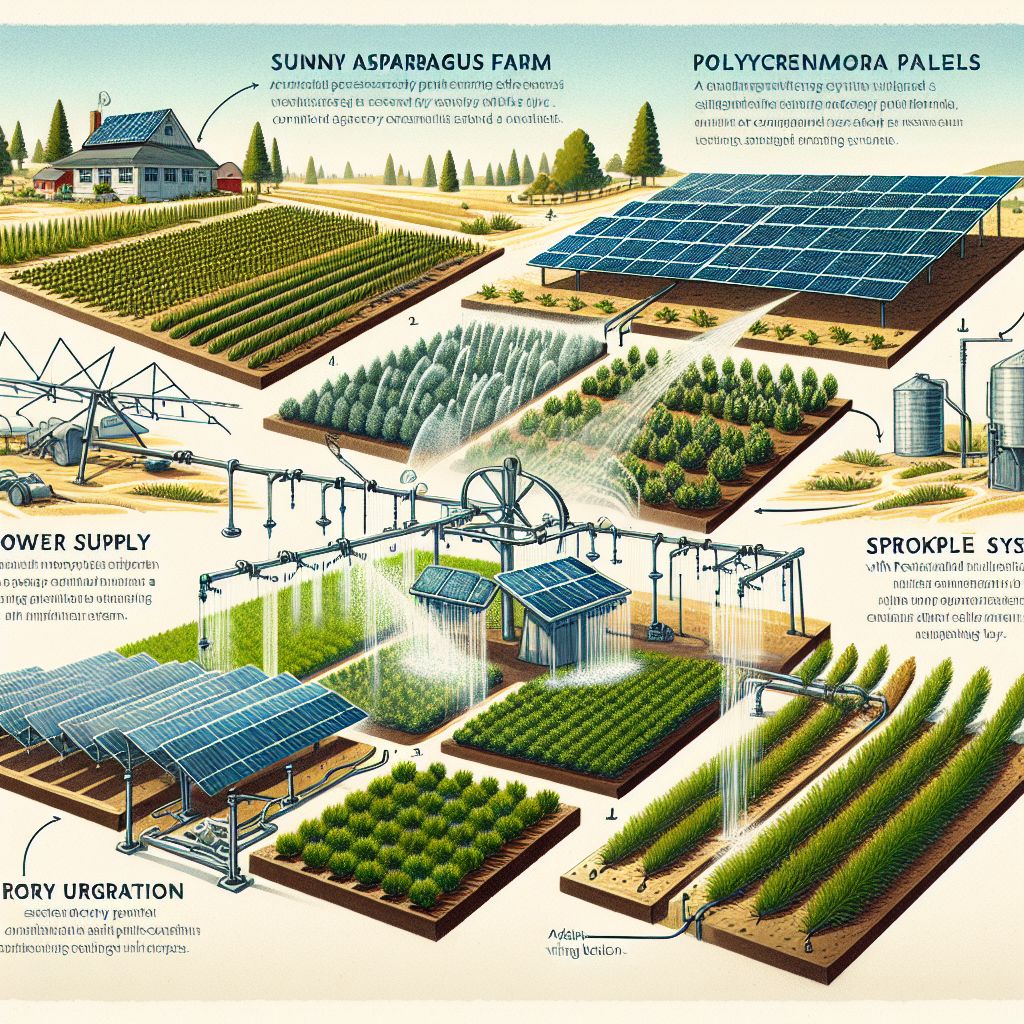
What’s the Best Mix: Matching Solar Panels to Irrigation Systems for Asparagus Farming
Identifying the best mix of solar panels and irrigation systems for asparagus farming involves a trade-off between cost, efficiency, and the unique requirements of your crop.
Combining Solar Panels and Drip Irrigation
Drip irrigation is a water-saving system, and when used with high-efficiency monocrystalline solar panels, it allows for maximum water and energy use. This combination is perfect for asparagus farms in sunny, dry areas where saving water is crucial.
Moreover, the accuracy of drip irrigation encourages the growth of healthy roots, which is essential for asparagus that stay in the ground all year. The focused watering method decreases the chances of disease and nutrient runoff, resulting in healthier plants and possibly greater yields.
Improving Sprinkler Systems with Solar Energy
For those who use a sprinkler system, polycrystalline panels may be the most cost-effective and efficient option. Although sprinkler systems aren’t as water-efficient as drip systems, they can still take advantage of the steady power supply that solar energy offers, ensuring a regular and consistent watering schedule.
How Furrow Irrigation Works with Solar Power
Thin-film solar panels could be a good match for farms that use furrow irrigation. They can be installed in a wide range of locations, which means they can be added to farms that may not be set up in a traditional way. But furrow irrigation doesn’t control water as precisely, so it’s important to manage it well to avoid wasting water.
In the end, the best choice for your asparagus farm will be based on a variety of factors, such as your location, the type of soil you have, the availability of water, and your budget. By taking these factors into account and seeking advice from solar and irrigation professionals, you can create a system that not only conserves water and energy, but also increases the productivity and sustainability of your farm.
What is the Best Option
When it comes to solar-powered irrigation for asparagus farming, the best option is the one that aligns with your farm’s unique characteristics and your sustainability goals. A combination of high-efficiency monocrystalline panels and a drip irrigation system is generally the most effective and eco-friendly choice. However, the right solution for your farm may vary depending on factors like climate, soil type, and water availability. Careful analysis and possibly some professional advice will ensure you make the best choice for your specific situation.
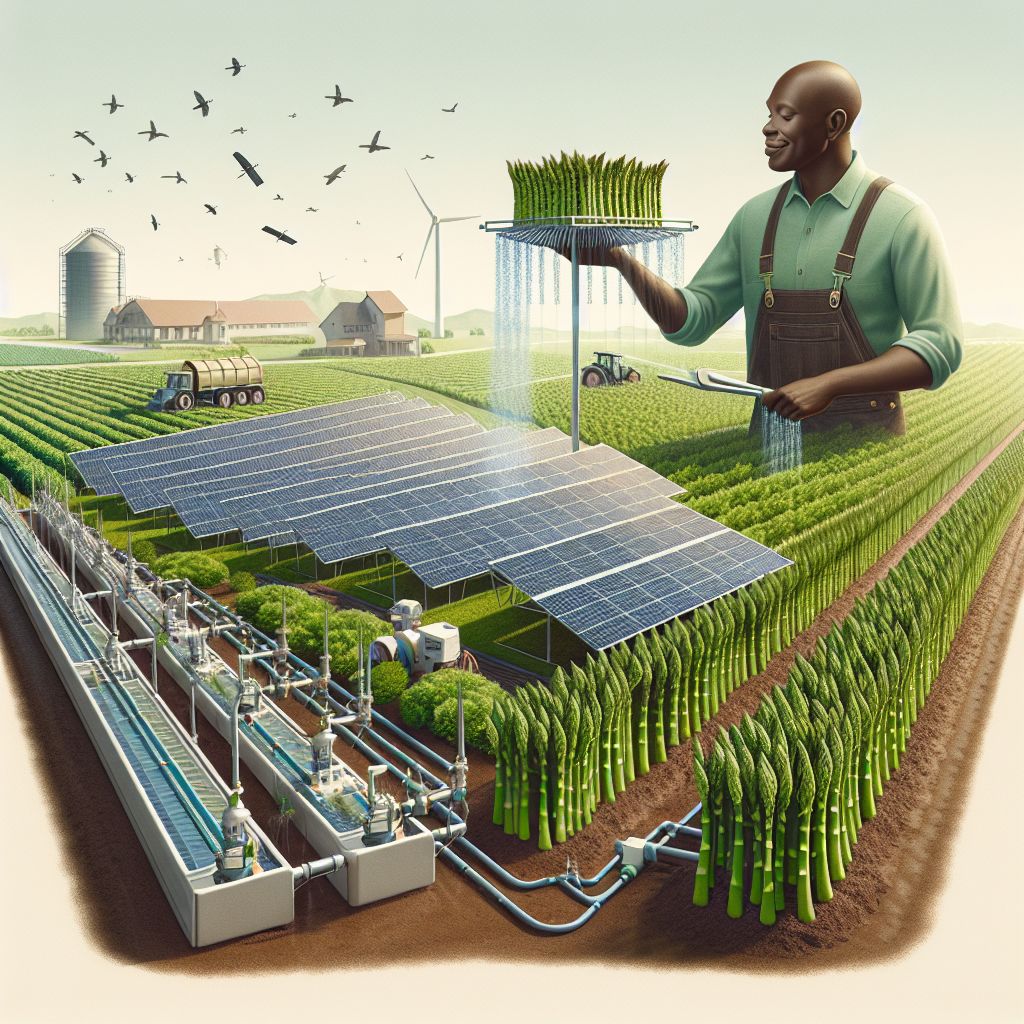
Conclusion: Is a Solar-Powered Irrigation System a Wise Investment for an Asparagus Farmer?
Irrigation is a must for asparagus farmers. Adding solar power to the equation takes a good system and makes it even better. While the upfront costs of solar panels may seem high, the long-term benefits—lower energy costs, increased crop yields, and a reduced carbon footprint—make it a sound and forward-thinking choice. Solar-powered irrigation systems are where old school farming and new school technology meet, and they are indeed a smart move for the environmentally conscious farmer.
John Doe, an asparagus farmer, cut his energy costs by 60% when he switched to a solar-powered drip irrigation system. He also noticed an increase in his crop yields because the watering schedule was more consistent and efficient.
It’s undeniable: solar power is more than just a fad, it’s a practical solution for today’s farming. When you invest in solar-powered irrigation, you’re setting up your farm to be more resilient, sustainable, and profitable in the long run.
Looking at the Ups and Downs of Asparagus Farming
There are many upsides to using solar-powered irrigation for asparagus farming, including energy independence, saving money, conserving water, and protecting the environment. The downsides, which are mostly the initial cost and finding a good place to put the solar panels, are minor compared to the long-term upsides. If you plan and carry out the switch to solar irrigation properly, it can be easy and very beneficial.
Is Solar Power the Future of Agricultural Irrigation?
Given the advances in technology and the increasing focus on sustainability, solar power is set to have a major impact on the future of agricultural irrigation. As more farmers turn to renewable energy solutions and spread the word about their successes, solar irrigation systems are likely to become a common sight in modern, environmentally-friendly farming.
What’s Next? Incorporating Solar-Powered Irrigation into Your Farming Methods
If you’re ready to dive into the world of solar-powered irrigation, begin by evaluating your farm’s energy requirements and consult with professionals to build the most effective system. Investigate local incentives and financing opportunities that can help alleviate the initial expenses. Then, take it one step at a time—switching to solar power is a big step, but with careful preparation and a little patience, you’ll soon experience the benefits of a more environmentally friendly, more efficient farm.
Frequently Ask Question:
1. What is the annual savings of a solar-powered irrigation system?
The annual savings of a solar-powered irrigation system can be quite significant. It really depends on the size of the system, the cost of electricity in your area, and the efficiency of your irrigation setup. However, many farmers have reported cutting their energy bills by half or even more after switching to solar power.
2. How long do solar panels last in a farming environment?
Solar panels are designed for durability, and most makers provide a warranty for 25 to 30 years. In a farming environment, your solar panels should retain much of their efficiency during this time, making them a worthwhile long-term investment for your farm.
3. Do government incentives exist for implementing solar power on farms?
Indeed, a number of governments provide incentives for adopting renewable energy, such as tax credits, rebates, and grants. These incentives can greatly decrease the expense of putting solar panels on your farm. Consult with your local and national agencies to find out what programs are accessible in your region.
4. Can solar panels generate enough energy to power large-scale irrigation systems?
With the appropriate design and enough solar panels, solar energy can fulfill the energy requirements of large-scale irrigation systems. The trick is to make sure that the system is sized appropriately for your energy needs and that you have the necessary infrastructure to support it.







Leave a Reply